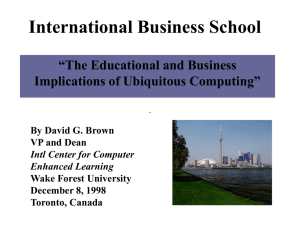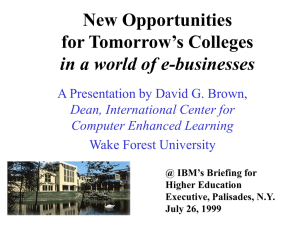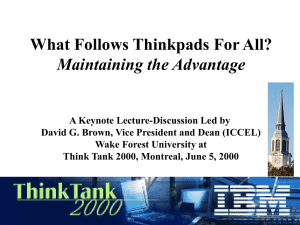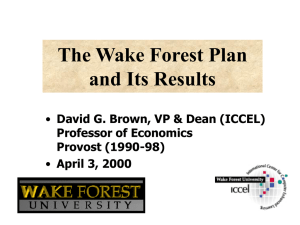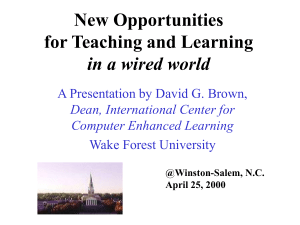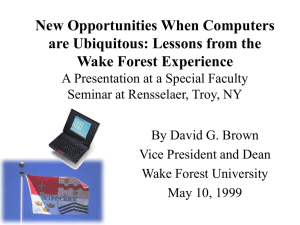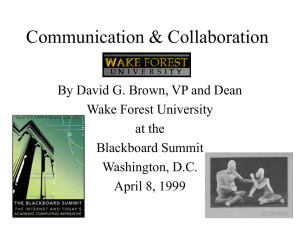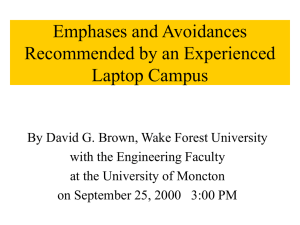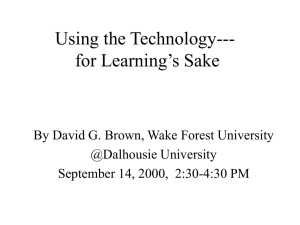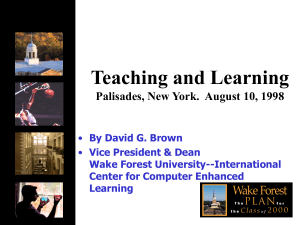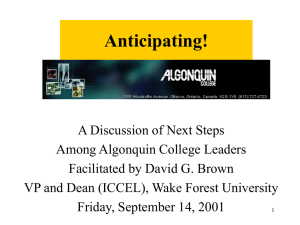Lessons Learned: Balancing the Costs and Benefits of Technology
advertisement
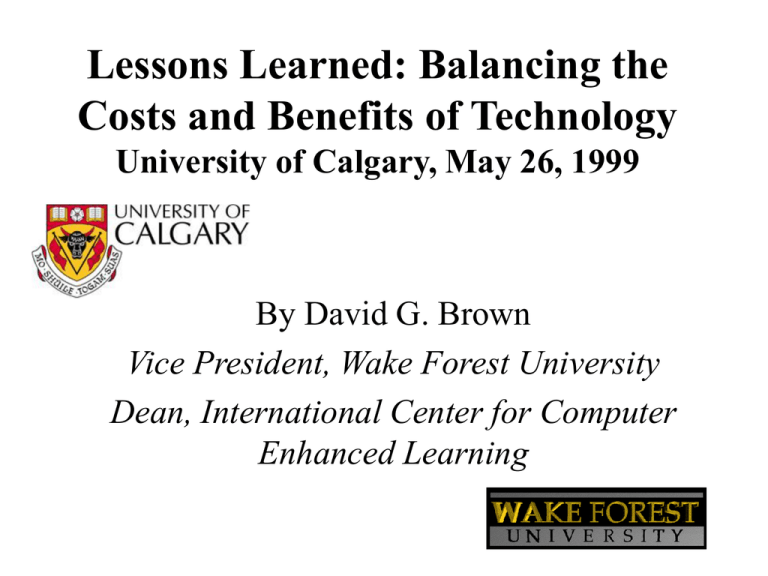
Lessons Learned: Balancing the Costs and Benefits of Technology University of Calgary, May 26, 1999 By David G. Brown Vice President, Wake Forest University Dean, International Center for Computer Enhanced Learning • 3600 undergrads • 92% residential • 500 each: Med, Law, MBA, PhD • $800M endowment • Winston-Salem NC • Baptist Heritage • Tim Duncan (ACC) • 1300 avg SAT • 29th USNWR • Top 35 Privates in Barron’s Guide • Rhodes Scholars • 1997 National Debate Champions THE WAKE FOREST PLAN F96: IBM 365XD, 16RAM, 100Mhz, 810MB, CD-ROM, 14.4 modem F97: IBM 380D, 32 RAM, 130Mhz, 1.35GB, CD-ROM, 33.6 modem F98: IBM 380XD, 64 RAM, 233 Mhz, 4.1GB, CD-ROM, 56 modem F99: IBM 390, 128RAM, 333 Mhz, 6 GB, CD-ROM, 56 modem • • • • • • Thinkpads for all New Every 2 Years Own @ Graduation Standard Template IGN for Faculty Keep Old Computers • 75% CEI Users • +15% Tuition • 4 Year Phase In 1999 Software Load Netscape 4.5, Dreamweaver 2, SPSS 9, Maple V 5.1 Windows 98, MS Office Prof 97 Consequences for Wake Forest • • • • +SAT Scores & Class Ranks +Retention & Grad Rates +Satisfaction & Learning +Faculty Recruitment With Ubiquity--The Culture Changes • Mentality shifts-- like from public phone to personal phone. • Teaching Assumptions shift-- like from readings are on reserve to everyone owns a copy of his/her own. • Timelines shift-- like from “our class meets MWF” to “we see each other all the time and MWF we meet together” • Students’ sense of access shifts-- like from “I can get that book in the library” to “I have that book in my library.” • Relationships shift-- like from a family living in many different states to all family members living in the same town 8 BASIC MODELS OF UBIQUITOUS COMPUTING (Ordered by total cost, starting with the most expensive) • • • • • • • • All + Powerful + Laptops + Annual Refresh Refresh Less Frequently Substitute Desktop Computers Provide One Computer Per Two Beds Specify Threshold Level Substitute Network Computers Provide Public Station Computers Teach with Explicit Assumption of Access WAYS TO REDUCE START UP COSTS • • • • • • • Annual Lease Phase in by classes Phase in by programs Phase in by type of program Phase in by category (faculty, students, staff) Hand me down Loaner Pool WHY COMPUTERS? …the institutional answer • • • • • • Communication! Level Playing Field After College Use Faculty/Students Demand Them Customized/Personalized Digitized Scholarship WHY COMPUTERS? …the faculty answer • • • • • • • Interactive Learning Learn by Doing Collaborative Learning Integration of Theory and Practice Visualization Communication Different Strokes for Different Folks Computers Enhance My Teaching and/or Learning Via-Presentations Better--20% More Opportunities to Practice & Analyze--35% More Access to Source Materials via Internet--43% More Communication with Faculty Colleagues, Classmates, and Between Faculty and Students--87% Lessons Learned LESSONS LEARNED • PC’s are only 10% of the Challenge (support/networks/policies/train/expose) • Most sunk costs can be ignored • Expectations need management • Develop a comprehensive plan first, and quickly match it with a multiyear financial plan LESSONS LEARNED • Standardization pays rewards well beyond those anticipated; non-standard configurations require 3-4 times support • Students/Faculty want specific computer training that is centered around a task-athand; general classes don’t work well • Be prepared to outsource challenges • Don’t wire to every seat • Use the internet for course materials LESSONS LEARNED • Reliability is critical, especially the Help Desk • Provide academic units staff of their own & plenty of equipment without hassle • Improve communications weekly; rumors fly faster • Spread the gains from & ownership of innovation throughout all units Lessons Learned • Contact becomes Continuous. • Students expect messages between classes • Team assignments increase • Papers & Talks often include visuals • Departmental clubs thrive • Student Portfolios Emerge • Students teach faculty ICCEL -- Wake Forest University, 1999 Lessons Learned • Computer knowledge is a boon to student recruitment, retention, self-confidence. • Computer knowledge is highly valued by students & prospective employers • Computer availability throughout the student body attracts new faculty • Computer challenged students learn basic skills quickly, without special classes • Disciplines use computers differently ICCEL -- Wake Forest University, 1999 Lessons Learned • Greatest benefits are what happens between classes, not during classes. • Greatest gains from computing come from “the big three.” • Standardization speeds faculty adoption and eases the pressure upon support staff. • Standardization saves class time. • Student groups are larger and more active. • Faculty migrate to the student standard very quickly ICCEL -- Wake Forest University, 1999 BIG ISSUES • • • • • • Laptop vs Desktop vs Network Standard vs Threshold Single Vendor vs Multiple Vendors Buy vs Lease vs Student Buy CourseInfo vs Web Course in Box Cold Turkey vs Pilot BIG ISSUES • Communication vs Presentation vs Analysis vs Access to Internet • Virtual Courses vs Hybrids • Academic vs Administrative • Consortia vs Going It Alone • Today’s Students vs Alums Also • Mandatory vs Optional Positioning for the Future • What are your institution’s strengths & weaknesses • How do you determine your place in an electronic world? • What will be your primary student markets--program areas? Degree credit? Geographic span? Age? • What are the appropriate delivery technologies next year? 5 years? Etc? • What is a realistic staffing plan? Outsourcing? Support personnel? Executive leadership? • What institutional partnerships make sense?
